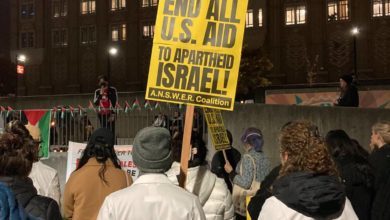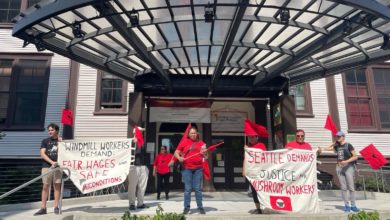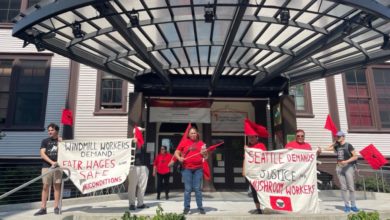On Nov. 23, in a
sham of a democratic process, the Board of Trustees of the Seattle
Community College voted unanimously to pass an emergency rule solely
intended to shut down the Occupy Seattle encampment at the Seattle
Central Community College campus. Following a national trend of
excuses for attacks on Occupy camps, the stated reason for the
shutdown was “health and safety concerns.”
Occupy Seattle
mobilized to pack the emergency meeting held at noon the day before
the Thanksgiving holiday. Only about half of the many people who
signed up to speak in the “public comment” session were permitted
to speak.
Among those who
spoke in support of Occupy Seattle were the leaders of the campus
unions, Karen Strickland of the Seattle Community College Federation
of Teachers and Rodolfo Franco of the Washington Federation of State
employees. Also speaking out were SCCC students affiliated with
Occupy and community-based Occupiers.
Numerous members
and supporters of Occupy Seattle spoke, pointing out that they had
sought to work with college administration; the administration
responded by attacking Occupy Seattle in the media. Occupy Seattle
supporters pointed out that they, the Occupy movement, were fighting
against budget cuts to higher education and thus were fighting for
the community college.
After closing down
the public comment session over the objections of those who had been
denied the right to speak, the Board showed a mainstream media news
piece on Occupy Seattle about an alleged attempted sexual assault at
the camp. Occupiers had discovered and interrupted the incident. The
alleged perpetrator was not a camp resident; in fact, he had been
asked to stay away from the camp previously due to earlier problems.
The college
administration is shamelessly exploiting legitimate concerns of women
about violence and sexual harassment—concerns that are shared by
women in the Occupy movement—as a reason to shut down the camp.
Sexual harassment and assault as well as other forms of violence
against women are endemic in our society and hardly unique to or more
prevalent at Occupy encampments.
Troy, an occupier,
in addressing the concern about allegations of drug use at the camp
(Occupy Seattle has adopted a no drugs/alcohol policy) pointed out
that “there were drunks and junkies in Capitol Hill” long before
Occupy Seattle moved its camp to the neighborhood. In fact, the South
Lawn of SCCC was a known gathering site for drug dealers and users.
Some of the conflicts that occurred at the camp had to do with the
struggle to eradicate drugs from the site. Regardless of the source
of the conflicts, the camp Peace and Safety committee has worked hard
to resolve situations non-violently.
The policy of the
Board of Trustees toward Occupy Seattle is not determined by safety
and health concerns. These are mere convenient pretexts to suppress
free speech activity and stifle the growing grassroots Occupy
movement by a board that is hand-picked by the governor and which,
faced with the grievances of a grassroots popular movement, will
unequivocally side with the 1 percent.
After allowing
members of the public a grand total of 17 minutes (one minute per
person) to comment on the proposal, members of the board and
administration were given unlimited time to utter innuendos and
half-truths about Occupy.
Over and over
again, they said that camping on campus was not part of the mission
of the college—as if occupiers were just taking a vacation, sitting
in their tents as Seattle’s famous rainy season begins! They
willfully ignored the point that occupying a public place is a means
to the end of building a movement that, if victorious, will further
the mission of the college to provide a quality public higher
education.
There was one sign
that the Board was on the defensive. Due to outrage over the recent
incident in which 84-year-old Dorli Rainey and other non-violent
protesters were pepper-sprayed and hit with bicycles by Seattle
police, the board made it clear that they were not going to call for
an immediate eviction of the camp. Chancellor Jill Wakefield stated
that they would strive for “an orderly process” of transition.
The emergency rule must be filed in the state capitol of Olympia on
the next business day, which is Monday, Nov. 28. Once that has
occurred, college staff will supposedly work with Occupy Seattle to
help them make a transition to a new location.
Many options are
now on the table as to how this movement will proceed locally. Many
Seattle occupiers plan to go to Olympia Nov. 28 for the Occupy the
Capitol protest against state budget cuts. Some may join the
encampment there, which for now is being left alone by the local and
state authorities. Currently, a small group of people who had been
occupying at SCCC have independently taken over an abandoned house in
the Central District and are occupying it with an eye to turning it
into a community center—such occupations have a long and proud
tradition in Seattle. Local organizers are mulling over other ideas
as well.
Returning to camp
after the meeting, the rain continued to pour down in near
record-breaking quantities. Supporters from the community were
dishing up turkey with all the fixings. Water was puddling up on the
brick steps leading down to the lawn area. Three of the canopies used
for the information and medical tents were in a state of collapse due
to the rain and wind. Thomas, an occupier, was spearheading an
attempt to rebuild the information and medical tent areas using some
new donated tents. However, they needed to first go get some pallets
to lay under the tents to keep water from seeping up.
This reporter
donated some zip ties, twine and a tarp to the effort. I also
collected some completely soaked jackets and pants from Thomas, which
were washed and returned dry later that day. As I came into the
darkened camp with the bag of laundry, the rain had abated. I found
Thomas and others working at the site of the medical tent. About 15
pallets had been laid down and they were removing the broken skeleton
of the old canopy. It was hard not to see symbolism in this
scenario—despite efforts to crush it, Occupy continues. It is an
embryonic form of a mass struggle that may ultimately clear away the
wreckage of an exploitative society, and lay the foundation for a new
society ruled by the 99 percent led by the working class.






